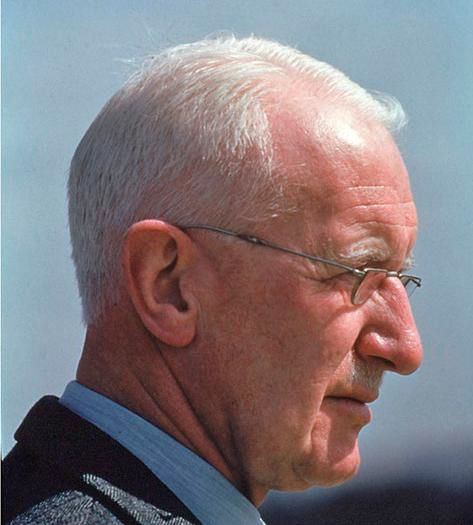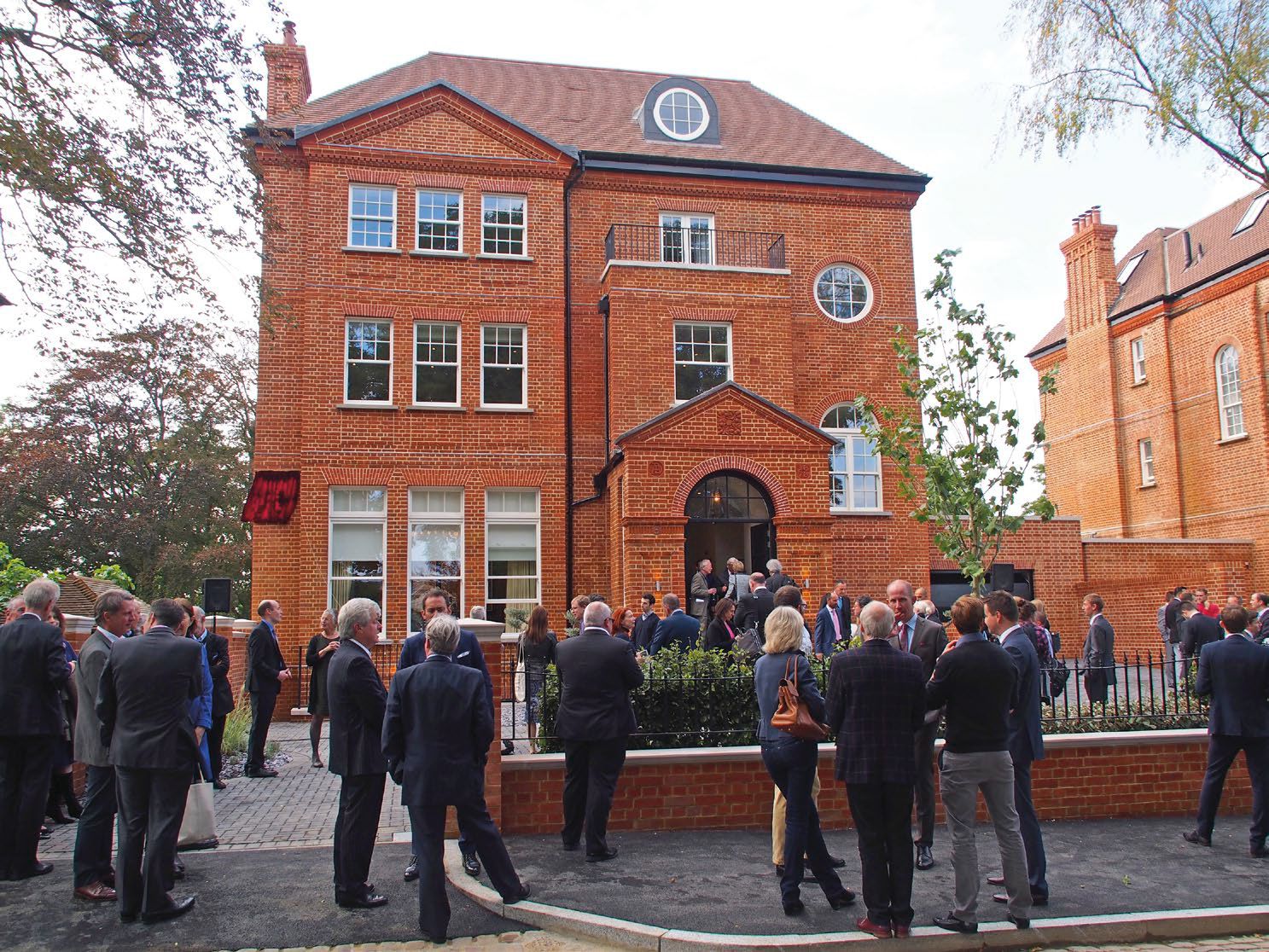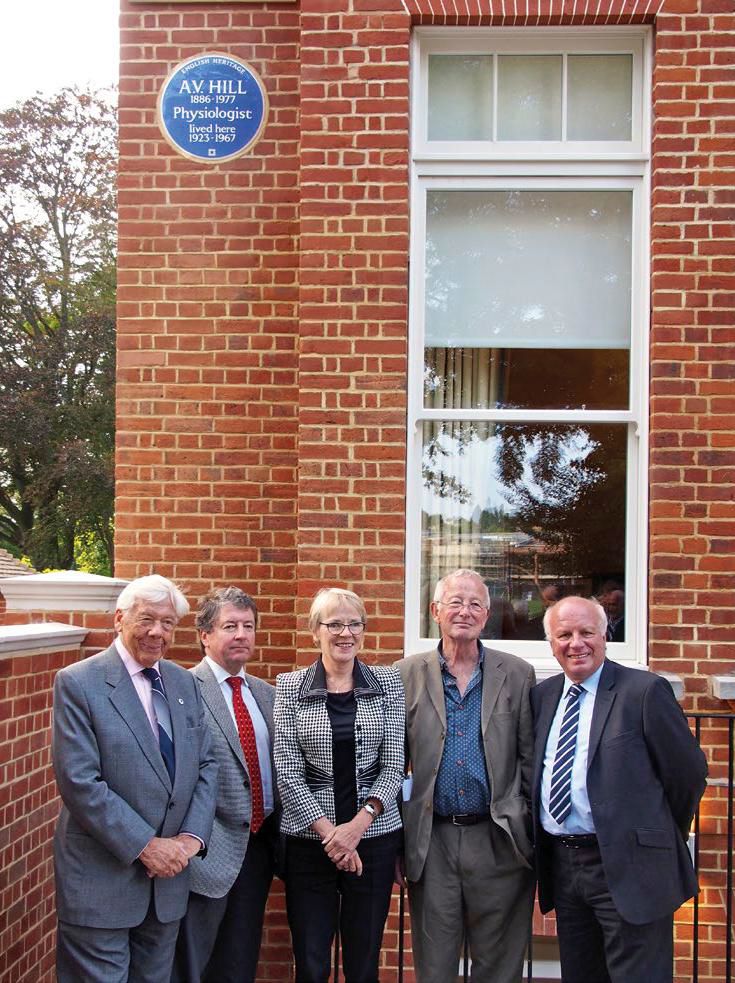
Physiology News Magazine
Blue Plaque at AV Hill’s former home
News and Views
Blue Plaque at AV Hill’s former home
News and Views
David Miller
Chair, History & Archives Committees
& Hon. Res. Fellow, University of Glasgow, UK
https://doi.org/10.36866/pn.101.16

The pre-eminent physiologist and humanitarian AV Hill’s former London home was at 16 Bishopswood Road, Highgate, North London. It has been owned by Highgate School since his death, and has recently been extensively refurbished by the architects, Atelier. English Heritage commemorated AV’s residence by unveiling a Blue Plaque at the house on 9 September 2015. The plaque describes AV simply as ‘Physiologist’. The only other plaque bearing that simple epithet is at Henry Dale’s former home (Mount Vernon House, Hampstead).
The event, sponsored by Atelier and the estate agents Savills, was attended by a number of AV’s extended family, together with dozens of other guests and dignitaries. Jonathan Ashmore, Fran Ashcroft and I represented The Society. Brief speeches were made by Greg Dyke (Chairman of The Football Association and former Director General of the BBC), Dr Julie Maxton (Executive Director, Royal Society), Prof Nicholas Humphrey (psychologist and philosopher), Stephen Wordsworth (CARA – Council for Assisting Refugee Academics) and Sir Ralph Kohn FRS (founder of the Kohn Foundation) who had proposed the Blue Plaque to honour AV’s memory. Amongst the speeches, Nicholas Humphrey (a grandson of AV) described that regular guests at the house included many Nobel laureates, AV’s brother-in-law, the economist John Maynard Keynes, and friends as varied as Stephen Hawking and Sigmund Freud. The afterdinner conversations involved passionate debates about science and politics. ‘Every Sunday [as a child] we would have to attend a tea party at grandpa’s house and apart from entertaining some extraordinary guests, he would devise some great games for us, such as frog racing in the garden or looking through the lens of a [dissected] sheep’s eye.’
Archibald Vivian Hill (1886-1977)–known to all as ‘AV’–was the first British winner of the Nobel Prize for Physiology or Medicine (in 1922/3), honoured for his early work on heat production in muscle. He is widely regarded as a founder of the discipline of biophysics, bringing his command of mathematics and physical principles to his work in physiology. His research work was fundamental in areas as varied as hormone-, neurotransmitter- and drug-receptor physiology, enzyme kinetics, muscle metabolism, nerve function, the mechanism of muscle mechanical function and more. One reason for the speech from Greg Dyke, representing the FA at the unveiling, is that aspects of AV’s work are also recognised as foundations of Sports Science: AV was himself a gifted athlete. He was mentor to several generations of leading physiologists. He led the physiology department at Manchester University (1920-23) and then at University College London (1923-1951). He joined The Society in 1912 and filled many major roles (Secretary 1927-33, Foreign Secretary 1934-45, served many years on the Editorial Board of JPhysiol). He was elected a Fellow of The Royal Society in 1918, going on to fill several senior roles (Council from 1932-4, Biological Secretary 1935-45, Foreign Secretary 1946) and held a Royal Society Foulerton Professorship. In World War II, he served as the (independent) MP for Cambridge University, his alma mater, and on government wartime science and technical committees.
Beyond his research, mentoring, government work, science administration and teaching, AV’s humanitarian work was exemplary. He played a leading role in setting up CARA (in 1933, with Ernest Rutherford, William Beveridge and others) and thus in the work to assist and support scientists escaping persecution in Nazi Germany. At the Blue Plaque ceremony, Sir Ralph Kohn referred to this endeavour: whilst still a child, Sir Ralph himself had escaped (together with his parents) from Leipzig in 1935. Sir Ralph reminded me that Bernard Katz had also escaped Leipzig the same year. He became a PhD student of AV and lived for some years as a lodger at AV’s home: thus there is a case for a further physiologist’s Blue Plaque at 16 Bishopswood Road.
Hill said and wrote much that is worthy of being quoted. As a champion of the value of unfettered original research, he observed in his Inaugural Lecture for the Jodrell Chair of Physiology at UCL in 1923 (when he succeeded Ernest Starling), ‘Medicine is continually demanding more information and help in the grievous and urgent problems which it has to solve – useful information, practical information, information which is likely to help heal … minds and bodies. It is impossible not to be moved by this appeal, and in their hearts there are few physiologists who do not hope that their work may prove, in some sense and at some good time, of service to mankind in the maintenance of health, in the prevention of disease, and in the art of science and healing. One’s heart, however, is not always one’s best guide; more useful in the end is the intellectual faith … which urges Tom, Dick and Harry in their humble way to explore each his own little strange and miraculous phenomenon, whether in the organic or inorganic world.’
[as quoted by Brian Jewell in Physiology News, Summer 2008, p12].



